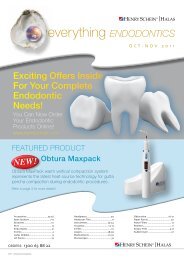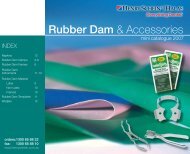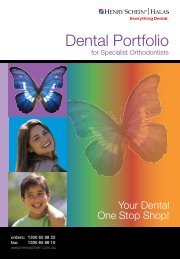The Cone Beam specialists - Henry Schein Halas
The Cone Beam specialists - Henry Schein Halas
The Cone Beam specialists - Henry Schein Halas
You also want an ePaper? Increase the reach of your titles
YUMPU automatically turns print PDFs into web optimized ePapers that Google loves.
high tech | DENTISTRY<br />
body logic<br />
imum and minimal (Figure 7) caliber of<br />
the airway space. Because of the relatively<br />
poor contrast resolution of CBCT<br />
imaging, potential specific soft tissue factors<br />
(e.g. muscular hypertrophy, redundant<br />
fat pads) are unable to be visualized.<br />
b. Ray-sum and maximum intensity projection<br />
simulated panoramic, lateral<br />
cephalometric, postero-anterio and submentovertex<br />
images. Specific volumetric<br />
rendering of the CBCT data can be<br />
performed to produce conventional craniofacial<br />
skull images. <strong>The</strong>se projections<br />
demonstrate global deficiencies of the maxillofacial<br />
skeleton in all three orthogonal<br />
planes that may contribute to the obstruction<br />
(e.g. retrognathia, maxillary cross-bite,<br />
mandibular asymmetry, palatal soft tissue)<br />
and allow visualization and measurement of<br />
parameters that have been reported to be<br />
associated with OSAHS (Figure 8).<br />
c. Regionally corrected temporomandibular<br />
joint images. Visualization of the TMJ<br />
articulation provides information of the<br />
relative stability of morphology of this<br />
determinant of mandibular position.<br />
Active degenerative joint disease either<br />
osteoarthritic, autoimmune or idiopathic<br />
in nature can reduce mandibular ramal<br />
length resulting in an anterior open bite<br />
and produce substantial inferior and posterior<br />
positional changes in the location of<br />
the associated soft tissue (Figure 9).<br />
d. Three dimensional analysis of upper<br />
airway anatomy. Concomitant segmentation<br />
of hard tissue maxillofacial skeleton,<br />
airway space and facial soft tissue surfaces<br />
from 3D CBCT data provides dynamic<br />
visualization of the interrelationship of<br />
these structures on airway obstruction.<br />
This facilitates identification and classification<br />
of the level of the obstruction (Table<br />
2) and quantitative analysis of linear, area<br />
and volumetric parameters (Figures 10 and<br />
11). Images also provide superior visualization<br />
of airway shape and caliber as well<br />
as soft tissue elements such as the<br />
epiglottis and soft palate. 18<br />
e. Comparison of pre- and post-therapy<br />
effects. Volumetric superimposition of CBCT<br />
datasets can be performed to produce<br />
colour-contrasted blended views of the<br />
mechanical and resultant airway changes<br />
as a result of specific therapies (Figure 12).<br />
In addition to the imaging protocol presented<br />
above, it is possible to generate<br />
video frame of reference “fly through”<br />
reconstructions (e.g. Osiris imaging Software.<br />
V3.1, University Hospital of<br />
Figure 8. Ray sum simulated lateral cephalometric images demonstrating tracing of<br />
soft (a) and hard tissue (b) measurements using specific orthodontic analysis software<br />
(Images created using Dolphin 3D V.11).<br />
Figure 9. Temporomandibular image protocol demonstrating ray sum reformatted<br />
panoramic (b), 5mm thick sagittal (a and b) and sequential 1mm cross-sectional right<br />
(d) and left (e) images. Note the marked osteoarthritic degenerative joint disease of the<br />
right TMJ articulation in this OSAHS patient contributing to reduction in mandibular<br />
ramal length and asymmetry of the mandible.<br />
Table 2. Classification of Velohypopharyneal Airway Obstruction 18<br />
Type Sub-Type Description<br />
I Retropalatal or velopharyngeal<br />
II Combined retropalatal and hypopharyngeal/retroglossal (base of tongue)<br />
IIa Predominantly retropalatal<br />
IIb Predominantly retroglossal<br />
III Isolated retroglossal or hypopharyngeal (base of tongue)<br />
14<br />
110 Australasian Dental Practice September/October 2009







